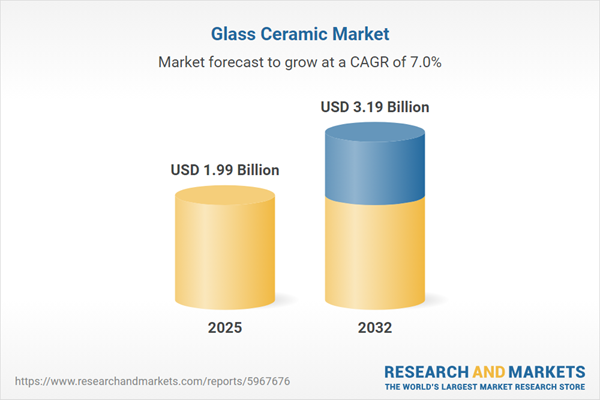Speak directly to the analyst to clarify any post sales queries you may have.
Senior leaders navigating digital transformation, compliance, and sustainability are increasingly prioritizing glass ceramics for operational resilience and innovation. As these demands intensify, glass ceramics offer organizations a dependable foundation to advance compliance, performance, and sustainability objectives within diverse operational environments.
Market Snapshot: Global Glass Ceramic Market Size and Dynamics
The global glass ceramic market is experiencing sustained, robust growth, with market value expected to reach USD 1.99 billion by 2025 at a CAGR of 6.96%. This trajectory is driven by expanding adoption in key sectors such as manufacturing and electronics, reflecting strong interest from organizations seeking new material innovations and lean supply solutions. As glass ceramic technologies evolve, businesses benefit from greater adaptability and responsiveness to changing standards, ensuring reliability remains central in product development and business strategy.
Scope & Segmentation of the Glass Ceramic Market
- End User Industries: Aerospace & Defense, Automotive, Construction, Consumer Goods, Electronics & Electrical, and Healthcare leverage glass ceramics for efficiency, longevity, adherence to sector-specific regulations, and consistent reliability.
- Product Types: Opaque varieties—blue, green, red, and white—and transparent options—low-iron clear, standard, bronze, and gray—allow organizations to meet coordinated design, brand, and technical requirements, supporting both visual flexibility and required clarity in finished products.
- Applications: Cookware & Bakeware, Industrial Equipment, Kitchenware, Lighting Fixtures, and Tableware & Serveware represent primary areas where glass ceramics enhance reliability and versatility for end users across global markets.
- Compositions: Lithium Alumino Silicate, Magnesium Alumino Silicate, and Zirconium Alumino Silicate display unique thermal, mechanical, and chemical properties. Enterprises select specific compositions to target performance needs such as maximizing heat resistance, maintaining structural integrity, or ensuring chemical durability.
- Regions: Americas, Europe, Middle East & Africa, and Asia-Pacific each introduce specific regulatory considerations, supply chain factors, and distinct operational risk profiles. Success hinges on adeptly navigating local compliance, logistics, and execution standards.
- Notable Companies: SCHOTT AG, Corning Incorporated, Kyocera Corporation, NGK Insulators Ltd., Morgan Advanced Materials Plc, Saint-Gobain S.A., CoorsTek Inc., CeramTec GmbH, Ferro Corporation, and Plansee SE provide industry leadership through technology expertise, supply strength, and field-proven reliability in advanced glass ceramic solutions.
Key Takeaways for Senior Decision-Makers
- Integrating glass ceramics supports compliance in regulated sectors, providing traceability and reliability demanded in aviation, healthcare, and infrastructure.
- Leveraging advanced manufacturing methods, including sol-gel and additive techniques, helps deliver tailored material solutions aligned with emerging specifications and industry demands.
- Optimizing supply chain practices directly contributes to enhanced cost management, strategic risk mitigation, and improved responsiveness to regulatory or market changes.
- Prioritizing recycled content and efficient waste management directly supports sustainability targets and stakeholder engagement objectives across the value chain.
- Digital transformation powered by Industry 4.0 accelerates production adaptation while enabling ongoing compliance with evolving industry standards and operational requirements.
- Regionally adaptive strategies enable scale in Asia-Pacific manufacturing, while organizations in the Americas and EMEA focus on process improvements and fulfillment excellence within established regulatory frameworks.
Tariff Impact: Navigating Market Shifts in the US Glass Ceramic Segment
Forthcoming tariff changes in the United States are prompting glass ceramic manufacturers and importers to review sourcing strategies. Companies are reinforcing local supply chains and establishing robust continuity plans to maintain competitiveness and resilience in an evolving policy environment.
Methodology & Data Sources
This report synthesizes broad sectoral datasets, scenario modeling of tariff developments, and direct insights from manufacturing and supply chain executives. All findings are reviewed by an independent panel, ensuring actionable relevance for decision-makers within the international glass ceramic market.
Why This Report Matters
- Empowers senior leaders to recognize, anticipate, and address new regulatory challenges and market disruptions affecting glass ceramic procurement and deployment.
- Enables organizations to proactively design resilient supply, compliance, and development strategies anchored in current best practices and sector benchmarks.
- Offers a framework for measuring operational performance, reducing complexity, and supporting strategic planning across multinational operations in the advanced materials sector.
Conclusion
Prioritizing digitalization and sustainability ensures glass ceramic market participants retain a competitive edge. Technical leadership and proactive regulatory alignment form the basis for lasting resilience and growth across evolving industry landscapes.
Additional Product Information:
- Purchase of this report includes 1 year online access with quarterly updates.
- This report can be updated on request. Please contact our Customer Experience team using the Ask a Question widget on our website.
Table of Contents
3. Executive Summary
4. Market Overview
7. Cumulative Impact of Artificial Intelligence 2025
Companies Mentioned
The companies profiled in this Glass Ceramic market report include:- SCHOTT AG
- Corning Incorporated
- Kyocera Corporation
- NGK Insulators, Ltd.
- Morgan Advanced Materials Plc
- Saint-Gobain S.A.
- CoorsTek, Inc.
- CeramTec GmbH
- Ferro Corporation
- Plansee SE
Table Information
| Report Attribute | Details |
|---|---|
| No. of Pages | 190 |
| Published | October 2025 |
| Forecast Period | 2025 - 2032 |
| Estimated Market Value ( USD | $ 1.99 Billion |
| Forecasted Market Value ( USD | $ 3.19 Billion |
| Compound Annual Growth Rate | 6.9% |
| Regions Covered | Global |
| No. of Companies Mentioned | 11 |









